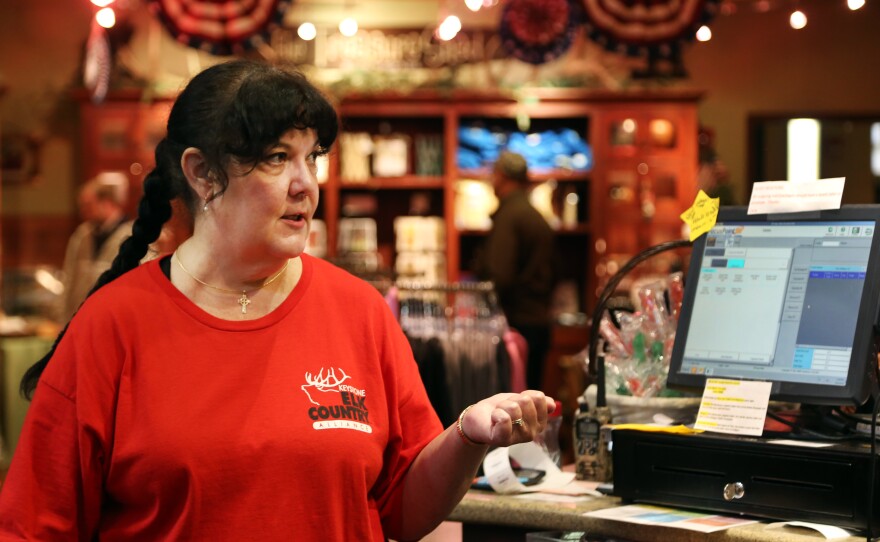In the fields and forests of Pennsylvania’s Elk County, love triangles, unrequited advances and fevered courtships have a unique soundtrack.
This story is part of Essential Pittsburgh, an ongoing series exploring how Pittsburgh lives, and how it's evolving.
“You mean the bugle,” said Joni Davis, park ranger with the state Department of Conservation and Natural Resources.
Gravel crunched beneath her boots on a trail just north of the Elk Country Visitor Center.
“We should’ve brought binoculars,” Davis said, pressing her hands against a damp, stone barrier. At the treeline 200 yards from man-made viewing areas, an undulating wail rose through the fog. She grinned.
“It’s their mating call,” she said, pointing. “It can be long or short. High-pitched or deep – sort of a howl – but not like a dog or coyote, you know? It’s always a little different depending how they use it.”
People love it, too.

Making a comeback
A few hundred years ago, wild Eastern elk herds ranged by the thousands through pastures and in the shadows of deciduous oak, maple and pine from New York State to Georgia. But by the 1860s, hunters had effectively exterminated them.
Early conservationists with the then-newly formed Pennsylvania Game Commission paid $30 a head for the first 177 Rocky Mountain Elk released between 1913 and 1926 into state forest lands. (Nerd note: Western elk [cervus elaphus nelsoni] are ecologically similar, but not genetically identical to their native eastern cousins [cervus elaphus canadensis], which are now considered extinct.)

The program had mixed reviews.
The first elk were initially dumped off the trains and allowed to wander at will. Farmers complained that crops were being eaten or destroyed. They tried brief hunting seasons, but too many animals got killed. Herd populations seesawed from several dozen to fewer than 200 elk for nearly 80 years.
But today, their descendants are doing pretty well.
Reclaimed strip mines and designated fields planted with clover, timothy grass, winter wheat, alfalfa, turnips and radishes have become important foraging habitats. Grazing lands grew from an initial 200 square miles to 800 square miles. Hunting is allowed, but expensive and highly regulated through a seasonal, state-run lottery.
Conservation officials celebrated when census figures recorded 300 elk in 1997. Since then, they’ve nearly quadrupled.

Drawing big crowds
Some of that credit belongs to the state’s new multi-million dollar visitor center. It sits on state land, but is managed by the nonprofit Keystone Elk Country Alliance.
“It’s something we’re really proud of,” said Meredith Hill, dubbed the “elk maven” by DCNR spokesman Terrance Brady.
As Director of the Pennsylvania Wilds -- an expansive program encompassing more than 2 million acres of public land across 12 counties, including wildlife areas, waterways, trails, scenic drives and lodging -- Hill has become one of the program’s biggest cheerleaders and fundraisers.
No trip to Elk County is complete without a stop by the new center, she said.

“Be patient. You’ve got to be patient here,” said Rachael Eckstine, 71, of Franklin County.
Her raincoat crinkled beside her husband, Carl.
“Here’s one with a whole bunch of girlfriends, and that one here, he just run these antlers around on the ground,” said Carl Eckstine, 72, tapping a Canon DSLR filled with elk photos from the previous day. “They’ll come up, and they’ll have stuff hanging all over their antlers. What did we see, 27 cows back there?”
His wife nodded, “Twenty seven cows with one bull yesterday. And we’ve seen more.”
Male elk, or bulls, are usually spotted in the fall lording over their harem -- a group of two or more females, or cows. Visitors sometimes note a couple calves lurking low in the grass beside older cows. The bugles, barks, chirps and moans are how they communicate, Eckstine said.

They’re also what draws the crowds.
In the peak of mating season, Davis said up to 5,000 people stroll through the 6-year-old visitor center on a given weekend, grabbing maps, gifts and boning up on what to look for and where to watch.
They celebrated their millionth visitor last year.
Brawling bulls
“Right now, they’re challenging each other,” said cashier and self-described country girl Patty Snelick. “They want their herd, and they try to steal from each other. The best guy wins.”
In her off hours, Snelick watches elk graze from her front porch in nearby Caledonia. The bull fights are the scariest, she said.
“When you see them fighting, you get back out of the way. Even you’ll see the young ones and the cows scatter.”

Baltimore freelancer Stuart Dahne comes back year after year, serving as an impromptu ambassador for elk watching, wildlife photography and safety protocol. He knows the hot spots, can detail early morning fights and recounts his exploits with all the reverence of a veteran not quite home from war.
“That’s a crazy bull,” he said, peering out over a long, camouflage-covered lens. “It gored a car yesterday and tried to broadside me.”
Dahne said he’s adored wildlife since he was 3 years old.
“It’s not a big moneymaker in photography, but it’s an absolute love,” he said.
The battles are the best, he said, the way the grass flies and their antlers clash.
“Tuesday night, the one bull, which we did not think would be the winner, pushed the one bull almost 100 yards. It was just amazing.”
Davis likened them to a different mammal.
“I refer to them as teenagers during this time of year,” she said. “They’re just really not thinking, and it’s kind of like, who can get the most cows.”
View a live stream from Elk County here.















